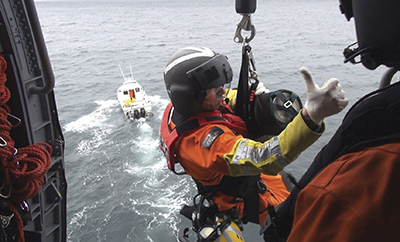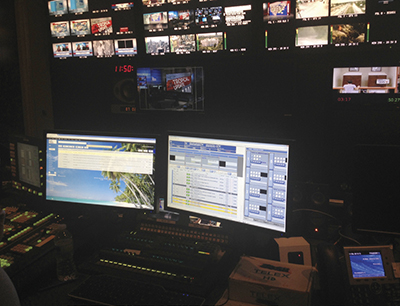Connecting ‘IT’ Together at The Weather Channel

To capture images from unpredictable weather spots all over the world—from the icy fjords of Alaska to the tundra of Northern Canada—The Weather Channel is employing a new IT-based infrastructure designed to offer greater flexibility back home.
ATLANTA—There is an undeniable appeal in watching soggy weathercasters tromp through howling hurricanes and hailstorms. But The Weather Channel has been able to stay atop the media market place for much of the last 30 years for a few reasons other than those. Entertainment value aside, The Weather Channel network has found success from behind the scenes—from its embrace of new media to its pack of roving broadcasters in the field—and the network is now pushing forward a new technology innovation from the IT world: a new production and broadcast infrastructure built on the auspices of an IT enterprise service bus, or ESB.
“This [platform] provides a generic way for everything to connect, allowing for any piece that can connect to the bus to talk to any other piece else on the bus,” said Philip Grossman, the system architect for TWC. “In the broadcast world, you’d typically buy a black box, or buy two for redundancy. Then when my needs change, a broadcaster would go buy another black box and replace them all. Now that we’re seeing this merger between IT and broadcast, there’s a lot more of an ability to communicate. There’s much to learn about what IT is doing and how it can help [broadcasting].”
CHANGE PARTS
The lessons to be taught are ones of interchangeability and expansion. The interchangeable nature of an ESB gives power back to the customer, according to John Scaggs, senior account manager at Harmonic in San Jose, Calif. “An age-old problem with any relationship between customer and vendor is that after the initial sale, the [power] is on the part of the vendor. The customer can’t go anywhere, can’t do innovation without a pretty significant investment.”
With an ESB, he said, a station can more easily change parts that are underperforming.
“They end up with a solution that’s designed adaptively and designed interactively,” Scaggs said. “What’s unique here is the willingness to put together a best of breed solution that gives them the scalability to be able to deal with multiple weather-based calamities simultaneously and on a big scale.”

TWC’s ESB system supports multiple infrastructure pieces: media asset management, ingest, transcoding and storage, all from a service perspective.
The professional video industry's #1 source for news, trends and product and tech information. Sign up below.
The system supports multiple infrastructure pieces: media asset management, ingest, transcoding and storage, all from a service perspective. “Storage is a service, ingest is a service, playout is a service, media asset management, production is a service,” Grossman said. “What it enables us to do is, if we need something more robust, is that I can more easily find another application, and once it’s in, I can stay with my storage, ingest, quality control and I don’t have to rip everything out.”
Integration of a new piece requires just one interface: the connection to the ESB. According to Grossman, any system plugged into the ESB can communicate smoothly with any other systems and devices.
As a result, since any system tied into the ESB may be used by any other connected system, it is proving easier for TWC to access historical data, audio and video. The network has been able to leverage this platform to provide additional programming and data to its other business units, including WSI, weatherchannel.com and Weather Underground. “Those units can leverage this for their B to B world,” Grossman said.
ADDING FUNCTIONALITY
The network has also set up a series of redundancies, with back up capability for the Sony Media Backbone solution as well as the Dalet media management system and various Harmonic solutions including MediaDeck ingest, MediaGrid storage, ProMedia Carbon transcode and Spectrum playout systems.

TWC’S master control The network continues adding functionality, he said, and recently streamlined access to its user-generated content, allowing it to be used by both broadcast and the Web. Later this year, the network will connect a distribution component for both Web and mobile. What’s proved most successful, Grossman said, “is the new ability to change them without impacting the system.”
“That enables us to quickly adapt to changes in the marketplace,” Grossman said. “If our Web team changes their user-generated content provider, it would just connect into our main platform and now all that material is easy to access.
“If we are going to make a deal with provider Y, for example, this [ESB platform] is helping us to think about areas where deals can be made or how content can be leveraged to be used across all platforms,” he said.
One of the more difficult things to do as a network is to futureproof a solution. “This design says, let’s truly make it automated so the same team of IT people can quadruple the output while still with a working team of five people,” Scaggs said. “Taking an EBS structure from the IT field to broadcast allows the network to provide scalability and innovation and a way to track material in a way that you haven’t done before.”
“When the next hurricane, tornado, or derecho hits,” Grossman added, “we will be able to cover it better than before on all platforms, because of this solution.”
Susan Ashworth is the former editor of TV Technology. In addition to her work covering the broadcast television industry, she has served as editor of two housing finance magazines and written about topics as varied as education, radio, chess, music and sports. Outside of her life as a writer, she recently served as president of a local nonprofit organization supporting girls in baseball.

